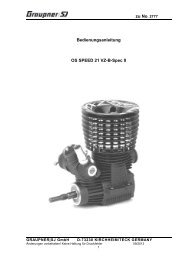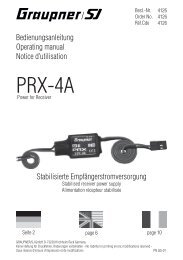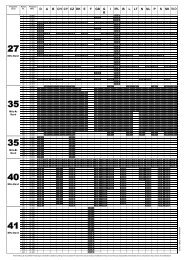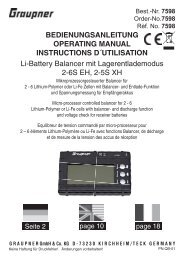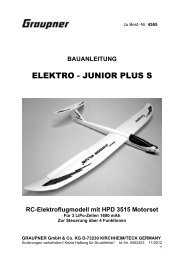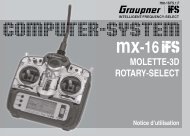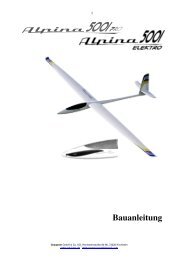Create successful ePaper yourself
Turn your PDF publications into a flip-book with our unique Google optimized e-Paper software.
Elevators<br />
To remove the excess wood and allow the elevators to deflect use the procedure<br />
shown in Figs. 67, 68, 69, 70, 71, 73. The following tools are required: hacksaw blade,<br />
balsa knife, screwdriver, and a hardwood strip around 4 mm wide.<br />
For technical reasons a strip of excess wood is left at the hinge position. To release<br />
the elevators run a balsa knife carefully along the machined slot on the underside, just<br />
touching the elasto hinge, then lever out the residual wood using a screwdriver or a 4<br />
mm wide strip of hardwood.<br />
Saw across the tailplane as far as the slot (elasto-hinge line) to produce the<br />
aerodynamic balance section. Carefully score along the line of the hinge gap on the<br />
top surface of the tailplane using a hacksaw blade (Fig. 73). Finally sand the hinge<br />
line gap and the tailplane, and seal the exposed styrofoam at the tailplane and<br />
elevator using 0.5 mm Ø balsa sheet or glass cloth and epoxy.<br />
Attach the elevator horns (51) to the elevators using the fixings supplied, as shown in<br />
Figs. 80 and 81. The horns and fixings are in the small parts bag VIII.<br />
Assemble the pushrods between the elevator servos and horns (Fig. 95) from M3<br />
clevises, M3 nuts (accessory pack VIII) and suitable lengths of M3 studding, as shown<br />
in Fig. 93.<br />
Wings and ailerons<br />
Release the ailerons from the wing panels using the same method and tools as<br />
described for the tailplane and elevators; see Figs. 69, 70, 72 and 73.<br />
On the underside of each wing panel (16) you will find two machined wells for the<br />
aileron servos. At this point (if not before) you must decide whether to use one or two<br />
high-performance servos for each aileron, and whether these are to be glued directly<br />
into the styrofoam, or installed using Servo-Locks designed for <strong>Graupner</strong>/JR servos<br />
(bag VI). If only one high-power servo is to be used, it must be installed in the inboard<br />
servo well.<br />
The machined wells are not the correct size for Servo-Locks, and if you wish to use<br />
these servo mounts you will have to enlarge the openings to suit; see Figs. 74 and 75.<br />
The wells are intentionally machined to a size suitable for accepting the servos<br />
directly, i.e. for the glued alternative; they can also be used to accept servos or servolocks<br />
made by other manufacturers.<br />
- Trim the servo well to accept the Servo-Lock (bag VI) and glue the unit in the well<br />
using UHU plus endfest 300. When the epoxy has cured, sand back the excess<br />
material flush with the wing using a sanding block (Fig. 76). If you have access to a<br />
bandsaw you may prefer to cut the Servo-Locks to the correct profile before gluing<br />
them in the wings.<br />
When the aileron servos (at least one high-power servo for each wing panel - right<br />
and left) have been installed, connect the servo leads to genuine <strong>Graupner</strong>/JR<br />
extension leads and deploy the cables in the factory-prepared ducts. The horns can<br />
then be installed in the ailerons and glued in place, as shown in Figs. 77, 78 and 79.<br />
The position of the horn or horns is shown in Fig. 77.<br />
15





